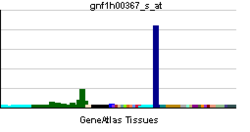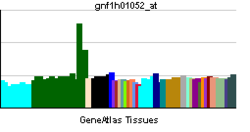- PCDH10
-
Protocadherin 10 Identifiers Symbols PCDH10; DKFZp761O2023; KIAA1400; MGC133344; OL-PCDH; PCDH19 External IDs OMIM: 608286 MGI: 1338042 HomoloGene: 74967 GeneCards: PCDH10 Gene Gene Ontology Molecular function • calcium ion binding Cellular component • plasma membrane
• integral to membraneBiological process • cell adhesion
• homophilic cell adhesionSources: Amigo / QuickGO RNA expression pattern 

More reference expression data Orthologs Species Human Mouse Entrez 57575 18526 Ensembl ENSG00000138650 ENSMUSG00000049100 UniProt Q9P2E7 n/a RefSeq (mRNA) NM_020815.1 NM_011043 RefSeq (protein) NP_065866.1 NP_035173 Location (UCSC) Chr 4:
134.07 – 134.13 MbChr 3:
45.18 – 45.24 MbPubMed search [1] [2] Protocadherin-10 is a protein that in humans is encoded by the PCDH10 gene.[1][2]
This gene belongs to the protocadherin gene family, a subfamily of the cadherin superfamily. The mRNA encodes a cadherin-related neuronal receptor thought to play a role in the establishment and function of specific cell-cell connections in the brain. This family member contains 6 extracellular cadherin domains, a transmembrane domain and a cytoplasmic tail differing from those of the classical cadherins. Alternatively spliced transcripts encode isoforms with unique cytoplasmic domains.[2]
References
- ^ Nollet F, Kools P, van Roy F (Jul 2000). "Phylogenetic analysis of the cadherin superfamily allows identification of six major subfamilies besides several solitary members". J Mol Biol 299 (3): 551–72. doi:10.1006/jmbi.2000.3777. PMID 10835267.
- ^ a b "Entrez Gene: PCDH10 protocadherin 10". http://www.ncbi.nlm.nih.gov/sites/entrez?Db=gene&Cmd=ShowDetailView&TermToSearch=57575.
Further reading
- Yagi T, Takeichi M (2000). "Cadherin superfamily genes: functions, genomic organization, and neurologic diversity". Genes Dev. 14 (10): 1169–80. PMID 10817752.
- Cross SH, Charlton JA, Nan X, Bird AP (1994). "Purification of CpG islands using a methylated DNA binding column". Nat. Genet. 6 (3): 236–44. doi:10.1038/ng0394-236. PMID 8012384.
- Wu Q, Maniatis T (1999). "A striking organization of a large family of human neural cadherin-like cell adhesion genes". Cell 97 (6): 779–90. doi:10.1016/S0092-8674(00)80789-8. PMID 10380929.
- Wu Q, Maniatis T (2000). "Large exons encoding multiple ectodomains are a characteristic feature of protocadherin genes". Proc. Natl. Acad. Sci. U.S.A. 97 (7): 3124–9. doi:10.1073/pnas.060027397. PMC 16203. PMID 10716726. http://www.pubmedcentral.nih.gov/articlerender.fcgi?tool=pmcentrez&artid=16203.
- Nagase T, Kikuno R, Ishikawa KI et al. (2000). "Prediction of the coding sequences of unidentified human genes. XVI. The complete sequences of 150 new cDNA clones from brain which code for large proteins in vitro". DNA Res. 7 (1): 65–73. doi:10.1093/dnares/7.1.65. PMID 10718198.
- Wu Q, Zhang T, Cheng JF et al. (2001). "Comparative DNA Sequence Analysis of Mouse and Human Protocadherin Gene Clusters". Genome Res. 11 (3): 389–404. doi:10.1101/gr.167301. PMC 311048. PMID 11230163. http://www.pubmedcentral.nih.gov/articlerender.fcgi?tool=pmcentrez&artid=311048.
- Wolverton T, Lalande M (2001). "Identification and characterization of three members of a novel subclass of protocadherins". Genomics 76 (1–3): 66–72. doi:10.1006/geno.2001.6592. PMID 11549318.
- Strausberg RL, Feingold EA, Grouse LH et al. (2003). "Generation and initial analysis of more than 15,000 full-length human and mouse cDNA sequences". Proc. Natl. Acad. Sci. U.S.A. 99 (26): 16899–903. doi:10.1073/pnas.242603899. PMC 139241. PMID 12477932. http://www.pubmedcentral.nih.gov/articlerender.fcgi?tool=pmcentrez&artid=139241.
- Ying J, Li H, Seng TJ et al. (2006). "Functional epigenetics identifies a protocadherin PCDH10 as a candidate tumor suppressor for nasopharyngeal, esophageal and multiple other carcinomas with frequent methylation". Oncogene 25 (7): 1070–80. doi:10.1038/sj.onc.1209154. PMID 16247458.
Categories:- Human proteins
- Chromosome 4 gene stubs
Wikimedia Foundation. 2010.
